人教版八年级英语下册教案Unit 3 第2课时
- 格式:doc
- 大小:51.50 KB
- 文档页数:5
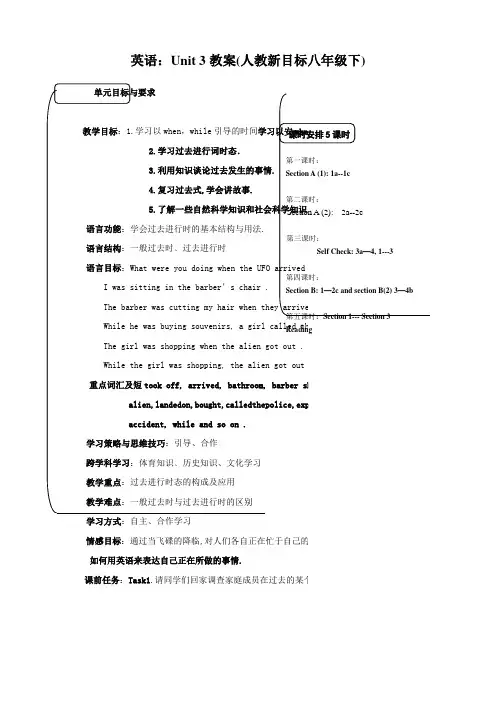
英语:Unit 3教案(人教新目标八年级下)学习方式:自主、合作学习情感目标:通过当飞碟的降临,对人们各自正在忙于自己的事如何用英语来表达自己正在所做的事情.课前任务:Task1.请同学们回家调查家庭成员在过去的某个时第一课时教学内容与分析教学内容:Section A (1): 1a---1c教学目标:1.能够掌握基本单词和词汇。
2.学会过去进行时的基本结构与用法。
3.能够运用以when 引导的时间状语从句。
4.能够运用基本句型进行提问。
学习任务:我的爱好目的:通过学生小组活动,调查在过去的不同时间里做不同的事情,学会使用过去进行时态,培养学生应用英语进行交际的能力。
语言技能:Listening .Speaking .Reading ﹑Writing语言知识:过去进行时的用法及复习一般过去时态提示词语及句型:got out, cut, barber shop, bathroom, kitchen, well, bathroomWhat were you doing when the UFO arrived ?I was sitting in the barber’s chair .The barber was cuttingmyhair when they arrived .教学重点、难点分析:教学重点:基本单词,词汇和句型教学难点:能够运用过去进行时谈论人们所做的事情.课前准备1.本课时的教学课件2.课前发给学生表格向学生布置任务:在表格中写出有关内容。
教学设计教学步骤建议和说明Teaching Steps :Step 1 :Warm-up and revision1.Share an English song .2.Greetings and free-talk .从平常的谈话中轻松导入本课句型,信息沟通使谈话非常真实,而又浅显What are you doing ? What did you do last night ?3.Show slides: Revise: is/an/are +动词ing4.Brain storm:Collect the names of activities which said by the students.Step 2 :Presentation :1.Watch a video2.By asking: What’s this in English ?Have you even seen it ?3.Teach:UFO, bedroom, bathroom, bedroom, kitchen,living-room, barber shopStep 3 :Work on:SB Page 18 , 1a .1.Point to the sentences .Read the sentences .Explain what each one means.2.Teach :barber shop, well, bathroom, bedroom, kitchen, get out, cut3.Look at the picture.. Point out the six people. Match the statements with the people in the picture4.Check the answers .5.Practice reading .Step 4 :Work on:SB Page 18 , 1b .1. Read the instructions .Make sure the Ss understand whatthey should do .2. Look at the dialogue in the picture .Explain :过去进行时态的构成: was / were + doing .用法:表示过去某一时刻或某一段时间正在进行的动作,一般用时间状语来表示。
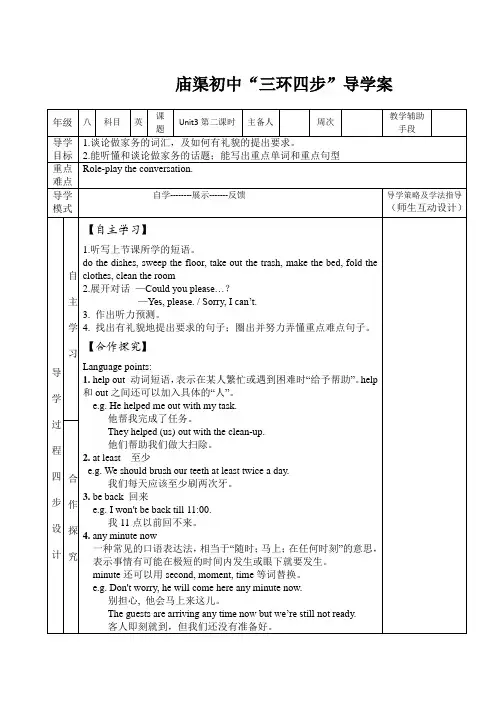
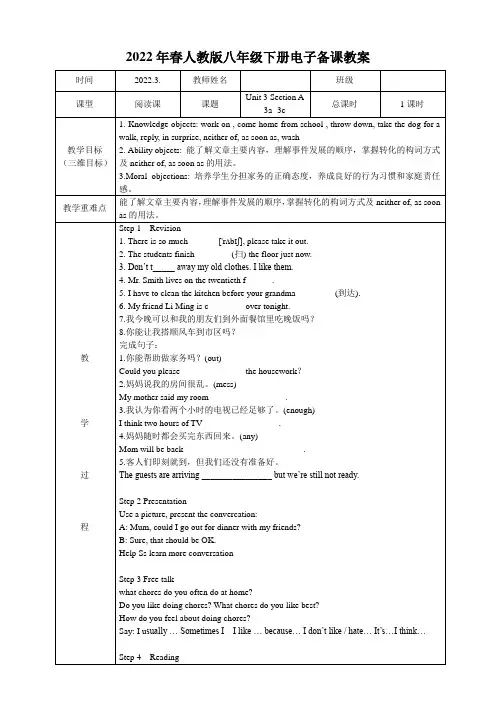
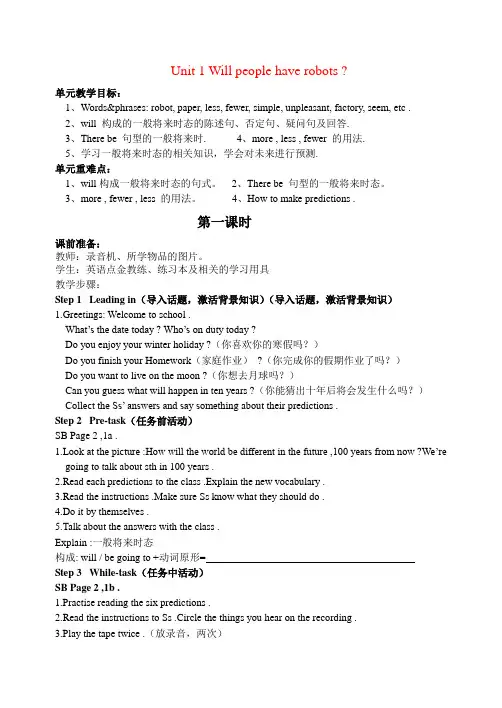
Unit 1 Will people have robots ?单元教学目标:1、Words&phrases: robot, paper, less, fewer, simple, unpleasant, factory, seem, etc .2、will 构成的一般将来时态的陈述句、否定句、疑问句及回答.3、There be 句型的一般将来时.4、more , less , fewer 的用法.5、学习一般将来时态的相关知识,学会对未来进行预测.单元重难点:1、will构成一般将来时态的句式。
2、There be 句型的一般将来时态。
3、more , fewer , less 的用法。
4、How to make predictions .第一课时课前准备:教师:录音机、所学物品的图片。
学生:英语点金教练、练习本及相关的学习用具教学步骤:Step 1 Leading in(导入话题,激活背景知识)(导入话题,激活背景知识)1.Greetings: Welcome to school .What’s the date today ? Who’s o n duty today ?Do you enjoy your winter holiday ?(你喜欢你的寒假吗?)Do you finish your Homework(家庭作业)?(你完成你的假期作业了吗?)Do you want to live on the moon ?(你想去月球吗?)Can you guess what will happen in ten years ?(你能猜出十年后将会发生什么吗?)Collect the Ss’ answers and say somethi ng about their predictions .Step 2 Pre-task(任务前活动)SB Page 2 ,1a .1.Look at the picture :How will the world be different in the future ,100 years from now ?We’re going to talk about sth in 100 years .2.Read each predictions to the class .Explain the new vocabulary .3.Read the instructions .Make sure Ss know what they should do .4.Do it by themselves .5.Talk about the answers with the class .Explain :一般将来时态构成: will / be going to +动词原形=Step 3 While-task(任务中活动)SB Page 2 ,1b .1.Practise reading the six predictions .2.Read the instructions to Ss .Circle the things you hear on the recording .3.Play the tape twice .(放录音,两次)4.Play the tape a third time .At the same time ,check the answers .SB Page 2 , 1c .1、Pay attention to the dialogues .2、Read the dialogues fluently .3、Pairwork .Work in pairs to make predictions according to the sample .4、Ask several pairs to share their conversations to the class .SB Page 3 , 2a & 2b .1、Read the predictions .2、Read the instructions and point out the sample answer .3、Play the tape twice .Ss circle the word they hear in each sentences: more , less , fewer .4、Check the answers .学生探究: less , fewer 的区别。
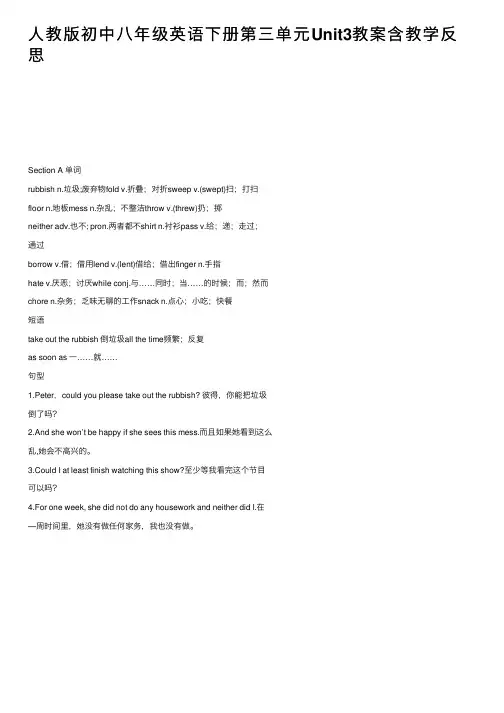
⼈教版初中⼋年级英语下册第三单元Unit3教案含教学反思Section A 单词rubbish n.垃圾;废弃物fold v.折叠;对折sweep v.(swept)扫;打扫floor n.地板mess n.杂乱;不整洁throw v.(threw)扔;掷neither adv.也不; pron.两者都不shirt n.衬衫pass v.给;递;⾛过;通过borrow v.借;借⽤lend v.(lent)借给;借出finger n.⼿指hate v.厌恶;讨厌while conj.与……同时;当……的时候;⽽;然⽽chore n.杂务;乏味⽆聊的⼯作snack n.点⼼;⼩吃;快餐短语take out the rubbish 倒垃圾all the time频繁;反复as soon as ⼀……就……句型1.Peter,could you please take out the rubbish? 彼得,你能把垃圾倒了吗?2.And she won’t be happy if she sees this mess.⽽且如果她看到这么乱,她会不⾼兴的。
3.Could I at least finish watching this show?⾄少等我看完这个节⽬可以吗?4.For one week, she did not do any housework and neither did I.在—周时间⾥,她没有做任何家务,我也没有做。
that everyone should do their part in keeping it clean and tidy.既然他们和⽗母⽣活在同⼀所房⼦⾥,他们就应该知道每个⼈都应该为保持房屋的⼲净和整洁尽⼀份⼒。
5.The earlier kids learn to be independent,the better it is for their future.孩⼦们越早学会独⽴,对他们的未来就越好。
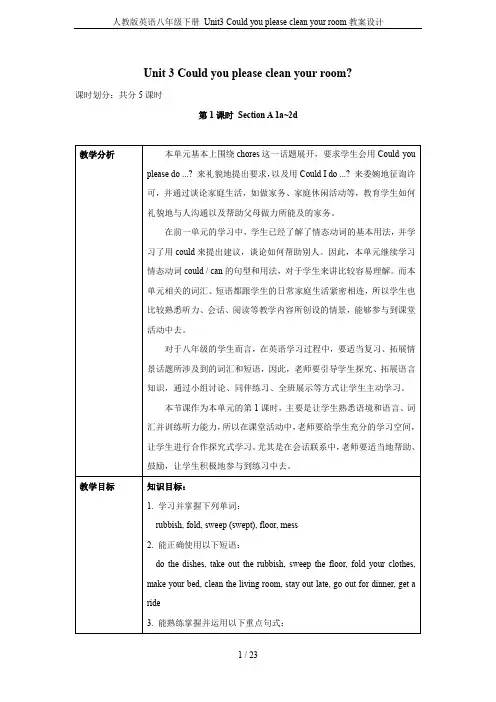
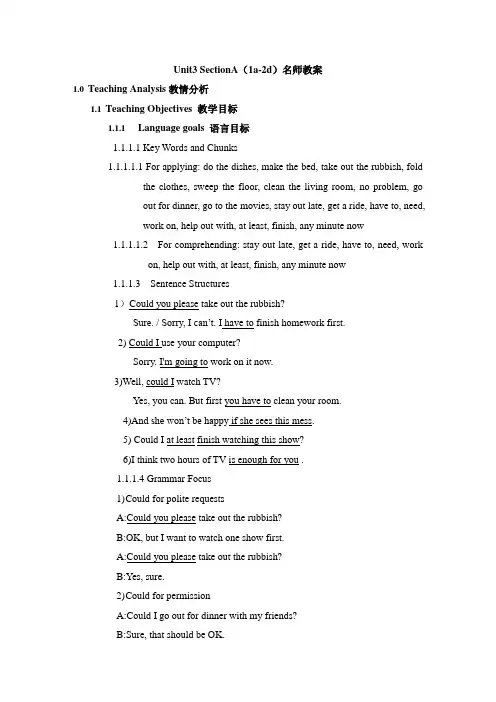
Unit3 SectionA(1a-2d)名师教案1.0Teaching Analysis教情分析1.1Teaching Objectives 教学目标1.1.1Language goals 语言目标1.1.1.1 Key Words and Chunks1.1.1.1.1 For applying: do the dishes, make the bed, take out the rubbish, foldthe clothes, sweep the floor, clean the living room, no problem, goout for dinner, go to the movies, stay out late, get a ride, have to, need,work on, help out with, at least, finish, any minute now1.1.1.1.2 For comprehending: stay out late, get a ride, have to, need, workon, help out with, at least, finish, any minute now1.1.1.3 Sentence Structures1)Could you please take out the rubbish?Sure. / Sorry, I can’t. I have to finish homework first.2) Could I use your computer?Sorry. I'm going to work on it now.3)Well, could I watch TV?Yes, you can. But first you have to clean your room.4)A nd she won’t be happy if she sees this mess.5) Could I at least finish watching this show?6)I think two hours of TV is enough for you .1.1.1.4Grammar Focus1)C ould for polite requestsA:Could you please take out the rubbish?B:OK, but I want to watch one show first.A:Could you please take out the rubbish?B:Yes, sure.2)C ould for permissionA:Could I go out for dinner with my friends?B:Sure, that should be OK.A:Could you get something to drink after the movie?B:No, you can’t. You have a basketball game to morrow.1.1.2Ability goals 能力目标1.1.2.1 教会学生用could礼貌地提出要求和征求许可。
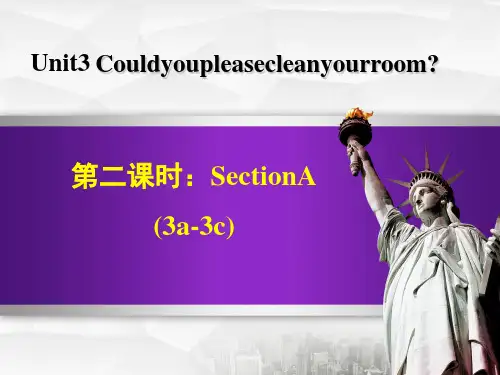
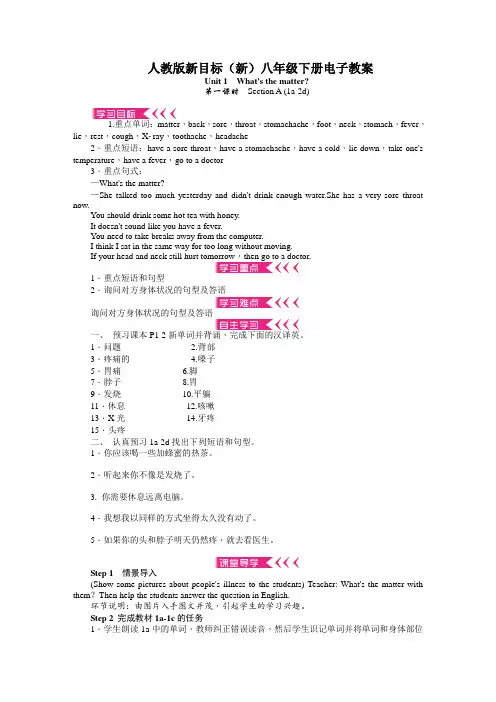
人教版新目标(新)八年级下册电子教案Unit 1What's the matter?第一课时Section A (1a-2d)1.重点单词:matter,back,sore,throat,stomachache,foot,neck,stomach,fever,lie,rest,cough,Xray,toothache,headache2.重点短语:have a sore throat,have a stomachache,have a cold,lie down,take one's temperature,have a fever,go to a doctor3.重点句式:—What's the matter?—She talked too much yesterday and didn't drink enough water.She has a very sore throat now.You should drink some hot tea with honey.It doesn't sound like you have a fever.You need to take breaks away from the computer.I think I sat in the same way for too long without moving.If your head and neck still hurt tomorrow,then go to a doctor.1.重点短语和句型2.询问对方身体状况的句型及答语询问对方身体状况的句型及答语一、预习课本P1-2新单词并背诵,完成下面的汉译英。
1.问题____________ 2.背部____________3.疼痛的____________ 4.嗓子____________5.胃痛____________ 6.脚____________7.脖子____________ 8.胃____________9.发烧____________ 10.平躺____________11.休息____________ 12.咳嗽____________13.X光____________ 14.牙疼____________15.头疼____________二、认真预习1a-2d找出下列短语和句型。
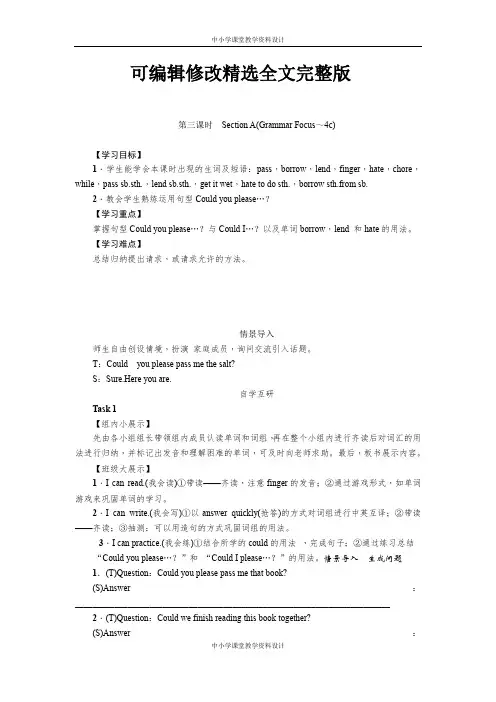
可编辑修改精选全文完整版第三课时Section A(Grammar Focus~4c)【学习目标】1.学生能学会本课时出现的生词及短语:pass,borrow,lend,finger,hate,chore,while,pass sb.sth.,lend sb.sth.,get it wet,hate to do sth.,borrow sth.from sb.2.教会学生熟练运用句型Could you please…?【学习重点】掌握句型Could you please…?与Could I…?以及单词borrow,lend 和hate的用法。
【学习难点】总结归纳提出请求,或请求允许的方法。
情景导入师生自由创设情境,扮演家庭成员,询问交流引入话题。
T:Could you please pass me the salt?S:Sure.Here you are.自学互研Task 1【组内小展示】先由各小组组长带领组内成员认读单词和词组,再在整个小组内进行齐读后对词汇的用法进行归纳,并标记出发音和理解困难的单词,可及时向老师求助。
最后,板书展示内容。
【班级大展示】1.I can read.(我会读)①带读——齐读,注意finger的发音;②通过游戏形式,如单词游戏来巩固单词的学习。
2.I can write.(我会写)①以answer quickly(抢答)的方式对词组进行中英互译;②带读——齐读;③抽测:可以用造句的方式巩固词组的用法。
3.I can practice.(我会练)①结合所学的could的用法,完成句子;②通过练习总结“Could you please…?”和“Could I please…?”的用法。
情景导入生成问题1.(T)Question:Could you please pass me that book?(S)Answer:________________________________________________________________________ 2.(T)Question:Could we finish reading this book together?(S)Answer:________________________________________________________________________自学互研生成能力Task 1Let's read the new words and phrases.1.I can read.(我会读)pass,borrow,lend,finger,hate,while,chore2.I can write.(我会写)(1)pass me the salt 递给我盐(2)come back too late 回来太晚(3)hate to do sth.讨厌做某事(4)finish reading 读完(5)hang out with my friends 与朋友闲逛(6)try(not)to do sth.尽量(不)做某事(7)get it wet 让它打湿(8)lend me some money借给我一些钱3.I can practice.(我会练)根据汉语意思完成下列句子,每空一词。
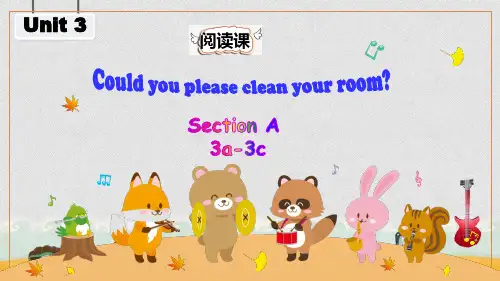
Unit 3 Could you please clean your room? 导学案Section A 2d—3a (阅读课)(第二课时知识目标: 1.掌握本课时的单词和短语。
2.学会礼貌地提出请求和请求允许做某事。
能力目标:通过小组合作探究与对话表演,提高合作共赢的能力和活学活用的能力。
情感目标:爱家庭,爱劳动,爱父母。
学习策略:完成阅读策略的“三步”,把握文章大意,获取信息,回答问题。
文化意识:了解西方国家孩子对家务劳动的态度。
重点:掌握并运用重点词汇和句子。
难点:对所学知识的灵活运用。
自主学习1.知识导航:(1). help out with a few things 帮忙做几件事(2). mess 常用可数名词单数:杂乱;不整洁eg. The room is in a terrible mess. 这个房间杂乱不堪。
(3). Could I at least finish watching this show? 至少等我看完这个节目可以吗?(4). Mom will be back from shopping any minute now. 妈妈随时都会买完东西回来。
(5). throw v. 扔;投掷(过去式:threw ) throw about 乱扔throw at 扔向(6). come over “过来”,动副词组,用作不及物动词,后面可接to sp.“过来到某地”(7). all the time “一直”,表示从某一特定阶段开始一直到结束,常用来修饰动词,多放在句末。
eg. If you are famous, people will watch you all the time. 教材学习:Step 1. Make a conversation in pairs about doing chores using make polite requests.Step 2. Read the conversation in 2d on P18 in pairs. Then discuss it with your partner.Step 3. Role-play the conversation.Step 4. 根据阅读策略,快速读课文并领会大意。
Unit 3 I’m more outgoing than my sister.Section A (Grammar Focus-3c)单词smarter, friendlier, funnier1.总结形容词及副词比较级的构成。
2.学习对两者进行比较的句型。
1.掌握句型“A+谓语+比较级+than+B”。
2.掌握句型“A+谓语+as+原级+as+B”。
Step 1检测上节课的学习效果,同时巩固已学知识,为新课做好准备1.Review the words①Show the pictures used in last class and ask Ss to describe the pictures using the words they learnt in last class.②Show the answers on the screen.2.Review the conversationAsk some Ss to recite the conversation in 2d.Step 2将独立思考和小组探究的方式结合,既培养了学生的思考能力,也培养了其合作能力。
Work on Grammar Focus①Ask Ss to read the sentences in the chart and then show the following questions on the PPT. Let Ss think by themselves.1)两者进行比较,表示“一方比另一方更……”的句型有哪些?2)两者进行比较,表示“一方与另一方一样……”的句型有哪些?3)两者进行比较,表示“一方不如另一方……”的句型有哪些?②Let Ss discuss those questions in groups of four and then write down their answers. Choose several groups to report their answers and then evaluate them.【Keys:1) A+ be + 形容词比较级+ than+BA+实义动词+副词比较级+than +B2)A+ be+as + 形容词原级+as +BA+实义动词+as+副词原级+as+B3)A+ be+ not+as(so) + 形容词原级+as +BA+ do/does+not+实义动词+as(so)+副词原级+as+B】Step 3再次锻炼学生的观察和总结能力;学生明确做题要求后,可以减少不必要的错误。
Teaching Plan forUnit 3 What were you doing when the UFO arrived?(Go For It)单元教材分析Unit 3以“What were you doing when the UFO arrived”为课题。
谈论如何使用过去进行时。
如何使用过去进行时是本单元的重难点。
通过观察图片,利用图片进行情景思维,学会讲故事,俩俩对话,角色扮演等形式和独立学习,合作交流,完成任务等来培养学生的综合语言运用能力,创新意识和实践能力。
总之,在本单元的教学全过程中,学生通过独立学习,角色扮演,实践体验,合作与交流的学习方式和任务型教学途径,通过掌握本单元的英语知识和技能,开发学生思维能力和发展个性,使语言学习的过程成为学生形成积极的情感态度,主动思维,大胆实践,使枯燥的语言变得丰富多彩,容易接受。
课时安排5/6课时第一课时:Section A (1a –1c)第二课时:Section A (2a—Grammar Focus)第三课时:SectionA (3a –4)第四课时: Section B 1—4a第五课时:(Self Check—Reading)教学计划Period 1 (1a –1c)Teaching key point:the usage of the past continuous tenseTeaching difficulties:How to use the past continuous tense in the adverb clause of time leaded by “when”and “while”.The Analysis of Teaching ProcessStep 1 - - - Organization1.Exchange greetings with the Ss.Duty report: It is between two students. They are having a dialogue.Enjoy a clip of film about the UFOStep 2 - - - Revision1.Show four animation pictures on the screenAfter showing the pictures, ask:----What is Peter’s mother doing? ---She is cooking.---What is Peter’s father doing? ---He is watching TV.---What is Peter doing? ---He is sleeping late.---What is Peter’s brother doing?. ---He is getting out of the shower教学设计说明复习进行时态2. Lead the students into the real situations:Ask one boy student: What are you doing now?The student may answer: I am listening to you.Ask the whole class: What is he doing?The whole class answer:He is listening to you.Repeat this with one girl student. Practice with the whole class, trying to revise the tense with different personal pronouns.教学设计说明同样复习进行时态,不同的是从图回到现实。
第二课时Section A(3a-4c) 课时目标
自主学习
一、根据句意及首字母或汉语提示写出单词。
1.Would you mind not throwing litter around?
2.Neither(两者都不)of them can speak Japanese.
3.Could I borrow some money from you? I have used up my money.
4.Linda used to hate(讨厌)doing chores.
5.While(当……的时候)we were having dinner,the bell rang.
二、写出下列画线短语的汉语意思。
1.I threw down my bag and went to the living room.扔下
2.Could you please take the dog for a walk? 带……去散步
3.Neither of us did any housework for a week.两者都不
教学过程
环节1新课导入
(教师通过PPT的方式呈现上一课时的关于家务事的图片)
T:Do you remember some expressions about doing chores? What is Peter doing in picture 1? S1:He’s taking out the rubbish.
T:Very good.And what is the girl doing in picture 2?
S2:...
然后让学生两人一组进行对话练习,复习上个课时的重点句型。
设计意图:通过复习的方式让学生巩固对已学知识的掌握,并自然引入本课时话题。
环节2学习3a-3c
1.让学生浏览3a的两个问题,为阅读文章做好准备。
2.让学生快速浏览3a的文章,并回答这两个问题,教师核对答案。
3.让学生精读文章,并勾画出文中的生词、重点短语、句子,教师进行讲解。
4.让学生熟读3a的文章,然后让学生分角色扮演南希和南希的母亲,把文章用对话的形式表演出来。
5.让学生浏览3b的句子,并从3a的文章中找出与之意思相同的句子,教师核对答案。
6.让学生大声朗读3c的句子,并按要求完成练习,教师核对答案。
7.要点点拨。
(1)The minute I sat down in front of the TV,my mom came over.
句中the minute作连词,意为“一……就……”,引导时间状语从句,其后省略了引导词that。
the minute还可与the moment、the instant、the second 等互换使用,minute 等词前还可用very修饰以示强调。
例:The(very)minute I got there,I heard the bad news.我一到那儿,就听到了那个坏消息。
(2)“Well,I work all day at school,too! I’m just as tired as you are!” I shouted back.
as...as...意为“和……一样……”,表示同级比较。
使用时要注意,第一个as为副词,其后接形容词或副词的原级;第二个as为连词,其后接比较的对象或情况。
其基本结构为:as+adj./adv.+as。
其否定形式为not as/so+adj./adv.+as。
例:This film is as interesting as that one.这部电影和那部电影一样有趣。
This dictionary is not as/so useful as you think.这本字典没有你想象的那样有用。
8.学以致用。
(根据汉语意思完成句子)
(1)他一到那里,我就告诉他。
I’ll tell him the minute he gets there.
(2)她的法语和英语一样好。
Her French is as good as her English.
(3)她老是忘记关灯。
She forgets to turn off the lights all the time.
设计意图:通过阅读,让学生学会在文中搜寻关键信息,同时学习一些重要知识点并能在实践中灵活运用。
环节3学习Grammar Focus-4c
1.让学生朗读并观察Grammar Focus中的句子,试着分析、总结could的用法规律。
2.教师向学生讲解Grammar Focus中的语法点。
3.让学生完成4a的练习,教师核对答案,并让学生两人一组练习这5个小对话。
4.让学生完成4b的练习,教师核对答案,并让学生分角色朗读对话。
5.小组练习。
让学生分组讨论露营前需要做的事以及谁去做,并列出清单,然后仿照4c方框中的对话进行对话练习。
教师邀请2至3组学生当堂表演对话。
6.要点点拨。
(1)情态动词could的用法
①could作为can的过去式,在过去时态中表示能力、推测、可能性等。
②在提出请求和征求许可时,could表示委婉的、礼貌的或不确定的语气。
其句型为:Could+主语+(please+)动词原形+其他?此时不能将could看作can的过去式。
③对could引导的一般疑问句的回答:肯定回答常用Yes,I can./Sure./Certainly./Yes,please./Of course(you may/can)./That’s OK.等。
否定回答常用I’m sorry I can’t./I’m really sorry but I...(先表示歉意,再说明理由)。
一般不用No,I/you can’t.因为这样很不礼貌。
(2)I’ll finish my homework while you help me with the dishes.
【辨析】while、when与as
while意为“当……时候”,强调同时性或某一时间段内一种情况发生时,另一种情况出现,与延续性动词连用;when可与延续或非延续性动词连用,在强调“当时,这时”之意时,用when;as强调同时性,意为“一边……一边……”,表示一件事情发生时,另一件事情同时进行。
7.学以致用。
(翻译句子)
(1)我正在做家庭作业,而我的父母正在看电视。
I was doing my homework while my parents were watching TV.
(2)在她小的时候,她就能画出很棒的图画。
When she was young,she could draw wonderful pictures.
(3)请把书递给我,好吗?
Could you please pass me the book?
设计意图:通过学习Grammar Focus中的句子,培养学生观察和总结语法规律的能力;然后,通过4a到4c的练习,让学生充分利用语言实践来掌握如何进行礼貌地请求、接受请求以及拒绝请求。
板书设计
练习设计
请完成本课对应训练!。